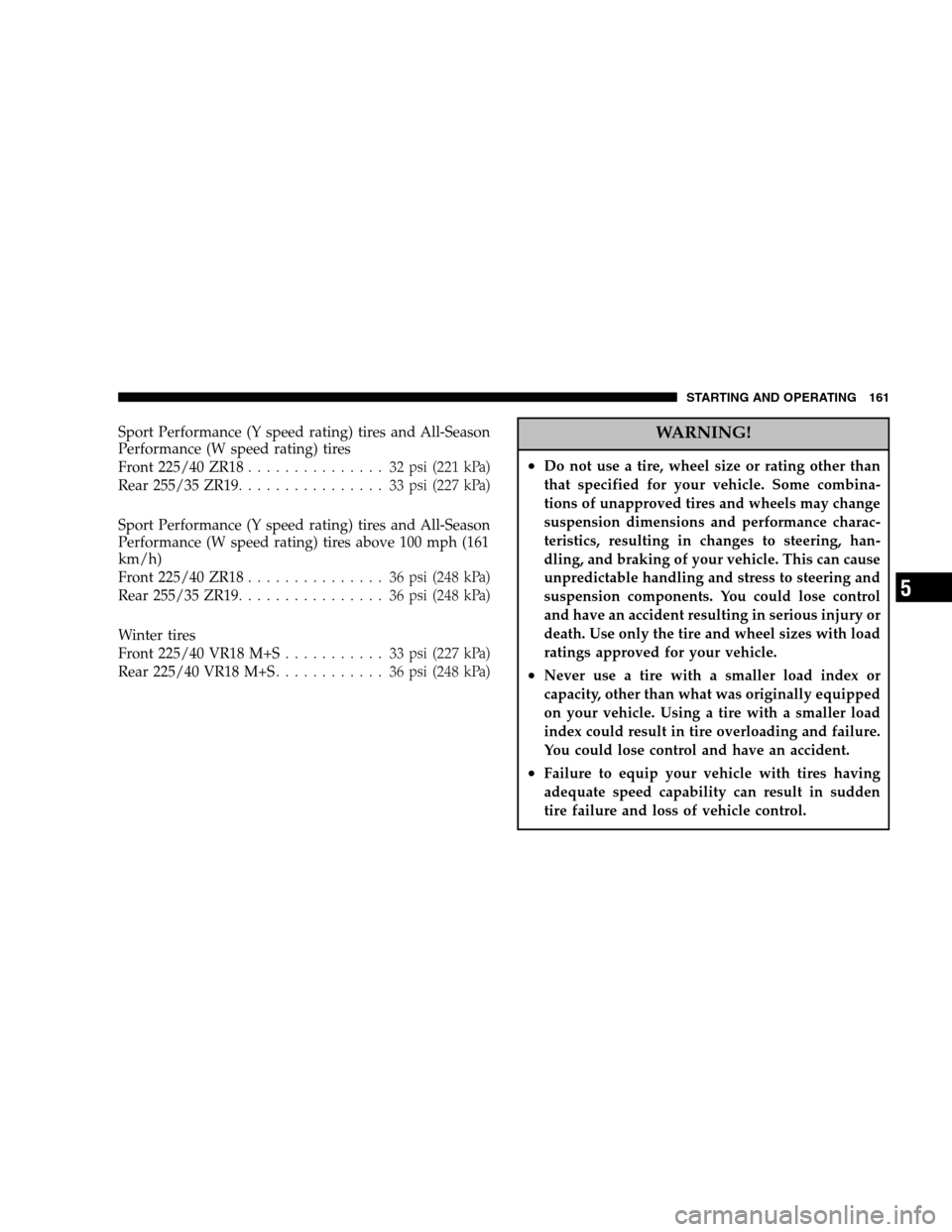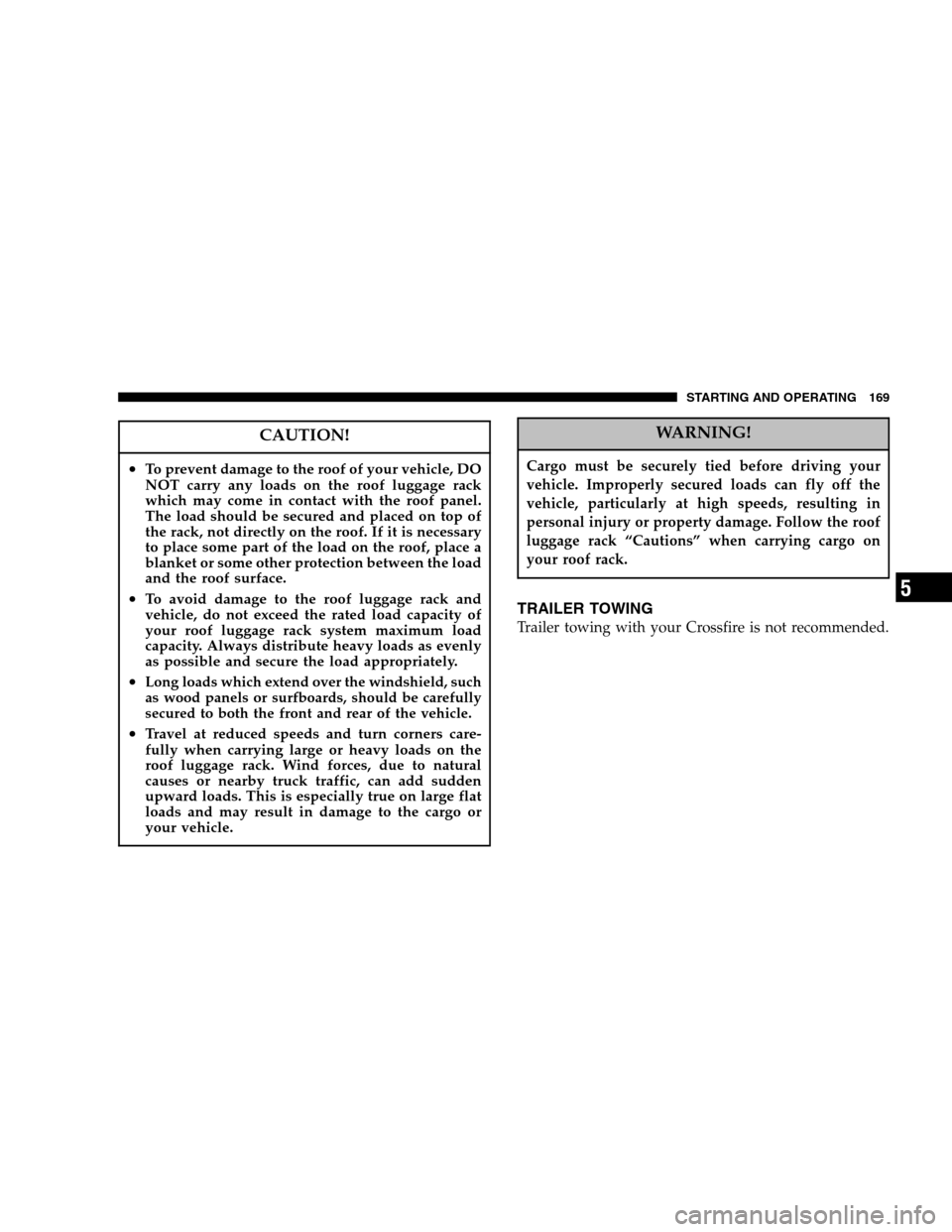CHRYSLER CROSSFIRE 2005 1.G Owners Manual
Manufacturer: CHRYSLER, Model Year: 2005, Model line: CROSSFIRE, Model: CHRYSLER CROSSFIRE 2005 1.GPages: 288, PDF Size: 24.37 MB
Page 161 of 288

Sport Performance (Y speed rating) tires and All-Season
Performance (W speed rating) tires
Front 225/40 ZR18............... 32psi(221 kPa)
Rear 255/35 ZR19................ 33psi(227 kPa)
Sport Performance (Y speed rating) tires and All-Season
Performance (W speed rating) tires above 100 mph (161
km/h)
Front 225/40 ZR18............... 36psi(248 kPa)
Rear 255/35 ZR19................ 36psi(248 kPa)
Winter tires
Front 225/40 VR18 M+S........... 33psi(227 kPa)
Rear 225/40 VR18 M+S............ 36psi(248 kPa)WARNING!
•Do not use a tire, wheel size or rating other than
that specified for your vehicle. Some combina-
tions of unapproved tires and wheels may change
suspension dimensions and performance charac-
teristics, resulting in changes to steering, han-
dling, and braking of your vehicle. This can cause
unpredictable handling and stress to steering and
suspension components. You could lose control
and have an accident resulting in serious injury or
death. Use only the tire and wheel sizes with load
ratings approved for your vehicle.
•Never use a tire with a smaller load index or
capacity, other than what was originally equipped
on your vehicle. Using a tire with a smaller load
index could result in tire overloading and failure.
You could lose control and have an accident.
•Failure to equip your vehicle with tires having
adequate speed capability can result in sudden
tire failure and loss of vehicle control.
STARTING AND OPERATING 161
5
Page 162 of 288

CAUTION!
Replacing original tires with tires of a different size
may result in false speedometer and odometer read-
ings. Check with your authorized dealer before
replacing tires with a different size.
Tire Rotation Recommendations
Tires on the front and rear axles of vehicles operate at
different loads and perform different steering, driving
and braking functions. For these reasons, they wear at
unequal rates, and tend to develop irregular wear pat-
terns.These effects can be reduced by timely rotation of tires.
The benefits of rotation are especially worthwhile with
aggressive tread designs such as those on all season type
tires. Rotation will increase tread life, help to maintain
mud, snow and wet traction levels, and contribute to a
smooth, quiet ride.
Rotate your tires at intervals shown on the maintenance
schedules. More frequent rotation is permissible if de-
sired. The reasons for any rapid or unusual wear should
be corrected before rotating.
162 STARTING AND OPERATING
Page 163 of 288

Alignment And Balance
The suspension components of your vehicle should be
inspected and aligned when needed to obtain full tire
tread mileage.
Poor suspension alignment may result in:
•Fast tire wear
•Uneven tire wear, such as feathering and one-sided
wear
•Vehicle pull to right or left
Tires may also cause vehicle to pull to the left or right.
Alignment will not correct this condition. See your
authorized dealer for proper diagnosis.
Improper alignment will not cause vehicle vibration.
Vehicle vibration may be a result of tire and wheel
out-of-balance. Proper balancing will reduce vibration
and avoid tire cupping and spotty wear.
STARTING AND OPERATING 163
5
Page 164 of 288

FUEL REQUIREMENTS
Your engine is designed to meet all emis-
sions regulations and provide satisfactory
fuel economy and optimum performance
when using high quality unleaded gaso-
line having an octane rating of 91 or
higher. DaimlerChrysler Corporation re-
quires the use of 91 octane or higher premium fuel to
minimize the potential for engine damage.
Light spark knock at low engine speeds is not harmful to
your engine. However, continued heavy spark knock at
high speeds can cause damage and should be reported to
your authorized dealer immediately. Engine damage
resulting from operating with a heavy spark knock may
not be covered by the new vehicle warranty.
Poor quality gasoline can cause problems such as hard
starting, stalling and stumble. If you experience these
problems, try another brand of gasoline before consider-
ing service for the vehicle.Over 60 automobile manufacturers around the world
have issued and endorsed consistent gasoline specifica-
tions (the World Wide Fuel Charter, WWFC) to define
fuel properties necessary to deliver enhanced emissions,
engine performance, and durability for your vehicle.
DaimlerChrysler Corporation recommends the use of
gasolines that meet the WWFC specifications if they are
available.
Reformulated Gasoline
Many areas of the country require the use of cleaner
burning fuel, referred to as “Reformulated Gasoline”.
Reformulated gasolines contain oxygenates and are spe-
cially blended to reduce vehicle emissions and improve
air quality.
DaimlerChrysler Corporation supports the use of refor-
mulated gasolines. Properly blended reformulated gaso-
lines will provide excellent performance and durability
of engine and fuel system components.
164 STARTING AND OPERATING
Page 165 of 288

Gasoline/Oxygenate Blends
Some fuel suppliers blend unleaded gasoline with mate-
rials called oxygenates such as 10% ethanol, MTBE and
ETBE. Oxygenates are required in some areas of the
country during the winter months to reduce carbon
monoxide emissions. Fuels blended with these oxygen-
ates may be used in your vehicle.
CAUTION!
DO NOT use gasolines containing Methanol. Use of
these blends may result in starting and drivability
problems and may damage critical fuel system com-
ponents.
Problems that result from using methanol/gasoline
blends are not the responsibility of DaimlerChrysler
Corporation and may not be covered by the Limited
Warranty. While MTBE is an oxygenate made from
Methanol, it does not have the negative effects of Metha-
nol.
MMT in Gasoline
MMT is a manganese containing metallic additive that is
blended into some gasolines to increase the octane num-
ber. Gasolines blended with MMT offer no performance
advantage beyond gasolines of the same octane number
without MMT. Gasolines blended with MMT have shown
to reduce spark plug life and reduce emission system
performance in some vehicles. DaimlerChrysler Corpo-
ration recommends using gasolines without MMT. Since
the MMT content of gasoline may not be indicated on the
pump, you should ask your gasoline retailer whether or
not his/her gasoline contains MMT.
MMT is prohibited in both Federal and California refor-
mulated gasolines.
In Canada, MMT can be used at levels higher than those
allowed in the United States. For this reason, it is even
more important to look for gasolines without MMT in
Canada.
STARTING AND OPERATING 165
5
Page 166 of 288

Materials Added to Fuel
All gasoline sold in the United States is required to
contain effective detergent additives. Use of additional
detergents or other additives is not needed under normal
conditions and would result in unnecessary cost. There-
fore, you should not have to add anything to the fuel.
Sulfur in Gasoline
If you live in the Northeast United States, your vehicle
may have been designed to meet California low emission
standards with cleaner burning California reformulated
gasoline with low sulfur. If such fuels are not available in
states adopting California emission standards, your ve-
hicle will operate satisfactorily on fuels meeting Federal
specifications, but emission control system performance
may be adversely affected.
Gasoline sold outside of California is permitted to have
higher sulfur levels, which may affect the performance of
the vehicle’s catalytic converter. This may cause the
CHECK ENGINE light to illuminate. DaimlerChrysler
Corporation recommends that you try a different brand
of unleaded gasoline having lower sulfur to determine if
the problem is fuel-related prior to returning your vehicle
to an authorized dealer for service.
CAUTION!
If the CHECK ENGINE Light is flashing, immediate
service is required. See the Onboard Diagnostic
System (OBDII) paragraph in the Maintaining Your
Vehicle section of this manual.
ADDING FUEL
Fuel Filler Cap (Gas Cap)
The gas cap is located under the fuel filler door, on the
passenger’s side of the vehicle. To open the door, be sure
it is unlocked, then gently press the rear edge of the door
until a click can be heard, then release. The door rear edge
will spring open enough to grasp and pull it completely
open. If the central locking system does not release the
fuel filler door, see your authorized dealer for service. If
the gas cap is lost or damaged, be sure the replacement
cap has been designed for use with this vehicle.
166 STARTING AND OPERATING
Page 167 of 288

CAUTION!
Damage to the fuel system or emission control
system could result from using an improper gas cap.
A poorly fitting cap could let impurities into the fuel
system. The CHECK ENGINE light will come on if
the gas cap is not properly secured.
NOTE:The fuel tank filler tube has a restricting door
about 2 inches (50 mm) down from the opening. If fuel is
poured from a portable container, the container should
have a flexible nozzle long enough to force open the
restricting door.
CAUTION!
To avoid fuel spillage and overfilling, do not “top
off” the fuel tank after filling.
With the key in the ignition switch turned to the ON/
RUN position, the fuel reserve warning light comes on. It
should go out immediately when the engine is running.
If the warning light does not go out after starting the
engine, or if it comes on while driving, it indicates that
the fuel level is down to the reserve quantity of approxi-
mately 2.1 gallons (8 liters).
Leaving the engine running and the fuel cap open can
cause the CHECK ENGINE light to illuminate.
NOTE:
•
When the fuel nozzle “clicks” or shuts off, the fuel
tank is full.
•Tighten the gas cap until you hear a single click. This
is an indication that the gas cap is properly tightene-
d.The CHECK ENGINE light will come on if the gas
cap is not properly secured. Make sure that the gas cap
is tightened each time the vehicle is refueled.
STARTING AND OPERATING 167
5
Page 168 of 288

WARNING!
•Never have any smoking materials lit in or near
the vehicle when the gas cap is removed or the
tank is filled.
•Never add fuel to the vehicle when the engine is
running.
•A fire may result if gasoline is pumped into a
portable container that is inside of a vehicle. You
could be burned. Always place gas containers on
the ground outside the vehicle while filling.
VEHICLE LOADING
The load carrying capacity of your vehicle is in the
following chart and on the tire pressure label attached to
the driver door pillar.
Vehicle Loading Capacities
Front Seat Occupants....................... 2
Cargo Capacity (with two persons).... 115lbs. (52 kg)
Rated Vehicle Capacity............ 415lbs. (188 kg)
Roof Luggage Rack
Convertible Top Vehicles
CAUTION!
To prevent damage to the convertible top, DO NOT
carry any loads on the convertible top.
Coupe Vehicles
External racks do not increase the total load carrying
capacity of the vehicle. Be sure that the total occupant
and luggage load inside the vehicle, plus the load on the
roof luggage rack, do not exceed the rated vehicle capac-
ity. The maximum recommended roof load for your
vehicle is 110 lbs. (50 kg).
168 STARTING AND OPERATING
Page 169 of 288

CAUTION!
•To prevent damage to the roof of your vehicle, DO
NOT carry any loads on the roof luggage rack
which may come in contact with the roof panel.
The load should be secured and placed on top of
the rack, not directly on the roof. If it is necessary
to place some part of the load on the roof, place a
blanket or some other protection between the load
and the roof surface.
•To avoid damage to the roof luggage rack and
vehicle, do not exceed the rated load capacity of
your roof luggage rack system maximum load
capacity. Always distribute heavy loads as evenly
as possible and secure the load appropriately.
•Long loads which extend over the windshield, such
as wood panels or surfboards, should be carefully
secured to both the front and rear of the vehicle.
•Travel at reduced speeds and turn corners care-
fully when carrying large or heavy loads on the
roof luggage rack. Wind forces, due to natural
causes or nearby truck traffic, can add sudden
upward loads. This is especially true on large flat
loads and may result in damage to the cargo or
your vehicle.
WARNING!
Cargo must be securely tied before driving your
vehicle. Improperly secured loads can fly off the
vehicle, particularly at high speeds, resulting in
personal injury or property damage. Follow the roof
luggage rack “Cautions” when carrying cargo on
your roof rack.
TRAILER TOWING
Trailer towing with your Crossfire is not recommended.
STARTING AND OPERATING 169
5
Page 170 of 288
